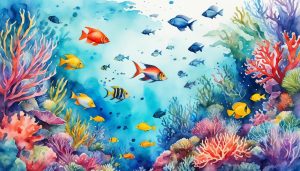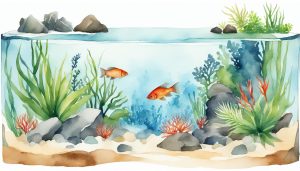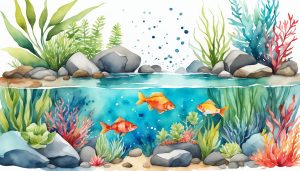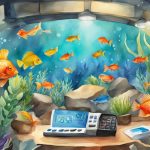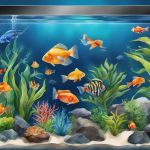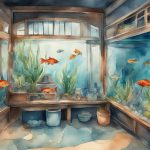Aquascaping is a captivating art form that allows me to create mesmerizing underwater landscapes in my aquarium. By incorporating rocks and driftwood into my aquascape, I can mimic natural environments and provide a haven for my fish. Both rocks and driftwood play pivotal roles in creating visually stunning and functional aquascapes.
Rocks add structure and visual interest to my aquascape, while providing hiding spots and spawning areas for my fish. There are various types of rocks that can be used, such as slate, river rock, lace rock, and even the natural stones found in my local environment.
Similarly, driftwood not only enhances the natural look of my aquascape, but it also serves as a support for attaching plants. I have a wide range of driftwood options to choose from, including Malaysian driftwood, Mopani wood, Sumatra driftwood, manzanita driftwood, spider wood, and more.
When incorporating rocks and driftwood into my aquascape, I need to ensure their safety for the aquarium environment. It is important to select rocks and driftwood that are safe for aquarium use and consider their impact on water chemistry and the overall aesthetic of my aquascape.
Key Takeaways:
- Utilizing rocks and driftwood in aquascaping creates visually stunning and functional underwater landscapes.
- Rocks provide structure, visual interest, and hiding spots for fish in the aquascape.
- Different types of rocks, such as slate and river rock, can be used to achieve unique effects in the aquascape.
- Driftwood enhances the natural look of the aquascape and provides support for attaching plants.
- Choosing safe rocks and driftwood is essential to maintain a healthy aquarium environment.
Aquarium Driftwood
When it comes to creating a natural and captivating look in your aquarium, driftwood is an essential element. Driftwood is wood that has been washed onto shores by natural forces like wind, tides, or waves. In the world of aquascaping, driftwood serves as both a decorative element and a functional component. It adds visual interest and provides structural support for attaching plants, creating a stunning underwater landscape.
There are several types of aquarium driftwood available, each with its own unique aesthetic qualities and effects on water chemistry. Here are some popular options:
- Malaysian driftwood
- Mopani wood
- Sumatra driftwood
- Manzanita driftwood
- Spider wood
- Saba driftwood
- Bogwood
- Cholla wood
- Tiger wood
- Pacific wood
- Bonsai tree wood
When selecting driftwood for your aquarium, it’s crucial to consider its safety and suitability for aquatic use. Some driftwood may release tannins or other substances that can alter water chemistry, potentially affecting the pH levels and the overall well-being of your aquatic inhabitants. It’s essential to choose driftwood that is safe for aquarium use and prepare it properly before adding it to your tank to minimize any negative impact on water quality.
Preparing driftwood for a planted tank involves a few essential steps:
- Cleaning: Start by thoroughly cleaning the driftwood to remove any dirt, debris, or impurities. Give it a gentle scrub using a soft brush to ensure it’s free from any unwanted substances.
- Boiling: Boiling the driftwood is an effective way to remove tannins and sterilize it. Place the driftwood in a large pot of water and boil it for about one to two hours. This process will help minimize the leaching of tannins into your aquarium water.
- Soaking: After boiling, soak the driftwood in a separate container of water to further leach out any remaining tannins. Change the water regularly until it remains clear, indicating minimal tannins are being released.
- Placement: Once the driftwood is clean and tannin-free, you can carefully position it in your aquarium. Consider the overall aesthetics and functional aspects of the aquascape when deciding on the placement of the driftwood.
- Monitoring: After adding driftwood to your aquarium, closely monitor water parameters, such as pH levels, to ensure they remain stable and suitable for your aquatic inhabitants. Make any necessary adjustments as needed.
By selecting the right type of driftwood, considering safety factors, and properly preparing it for your planted tank, you can incorporate this natural element into your aquascape while maintaining a healthy and visually appealing aquarium environment.
Rocks Commonly Used in Aquascaping

Rocks are an essential element when it comes to creating stunning aquascapes. They not only provide structure and visual interest but also play a crucial role in mimicking natural environments and creating a harmonious balance in the aquarium. Let’s take a closer look at some of the most common types of rocks used in aquascaping.
Slate
Slate rocks are widely favored for their beautiful dark coloration and flat, layered appearance. They can be stacked or arranged in various ways to create dramatic focal points in the aquascape. The unique texture of slate rocks adds a touch of elegance and sophistication to any aquarium.
River Rock
River rocks, as the name implies, are naturally rounded and smoothed by the flow of rivers and streams. These rocks come in a variety of sizes and colors, making them versatile for different aquascape designs. They can be used to create riverbank scenes or simply as accent stones to add depth and contrast to the layout.
Lace Rock
Lace rocks are known for their intricate and delicate appearance, resembling lace fabric. These rocks often have intricate patterns of holes and crevices, providing excellent hiding spots for fish and shrimp. They are also ideal for attaching mosses and epiphytic plants, creating a lush and natural-looking aquascape.
Texas Holey Rock
Texas holey rock is a type of limestone that is highly popular in aquascaping. It is characterized by its porous nature and distinctive holes, which are created by erosion over time. Texas holey rock not only adds visual interest but also contributes to the carbonate hardness (KH) and pH levels of the water, making it suitable for African Cichlid tanks.
Natural Stones
In addition to specific types of rocks, natural stones found in the local environment can be great choices for aquascaping. These stones often have unique textures, colors, and shapes that add a sense of realism to the aquascape. However, it’s important to properly clean and prepare these stones to ensure they are safe for the aquarium.
The relationship between driftwood and rocks in an aquascape is essential to create a cohesive and natural-looking layout. By combining these two elements, you can create captivating scenes that mimic the beauty of underwater landscapes. The driftwood provides a vertical element and serves as a focal point for attaching plants and creating hiding places, while the rocks offer stability and complement the overall design.
When selecting rocks for your aquascape, it’s essential to choose rocks that are safe for aquarium use. Some rocks may leach harmful substances or alter water chemistry, which can be detrimental to the health of your aquatic life. It’s always a good practice to research the specific type of rock and its potential impact on water parameters before adding it to your aquarium.
| Rocks | Appearance | Features | Suitable for |
|---|---|---|---|
| Slate | Dark coloration, layered | Flat, stacked | All Aquariums |
| River Rock | Smooth, rounded | Varied sizes, colors | All Aquariums |
| Lace Rock | Intricate, delicate | Provides hiding spots | Shrimp Tanks |
| Texas Holey Rock | Porous, distinctive holes | Affects KH and pH levels | African Cichlid Tanks |
| Natural Stones | Varied textures, colors | Local environment authenticity | All Aquariums |
Guide to Aquascaping Substrates
Aquascaping substrates are a crucial element in creating a harmonious and visually stunning aquascape. Sand and gravel substrates not only provide a foundation for plants and decorations but also play a significant role in maintaining the water chemistry of your aquarium.
When selecting aquascaping substrates, you have a range of options. Sand and gravel substrates offer different textures and visuals, allowing you to create unique landscapes in your aquarium. On the other hand, nutrient-rich substrates like aquasoils are ideal for promoting healthy plant growth. They provide essential nutrients and minerals while also influencing the cation exchange capacity (CEC) of the water.
The CEC value determines how well a substrate absorbs and releases nutrients, impacting the overall water chemistry and the well-being of your aquatic plants and fish. By choosing the right aquascaping substrate, you can create a balanced and thriving aquatic environment, making your aquascape not only visually appealing but also conducive to the health and growth of your aquatic life.


